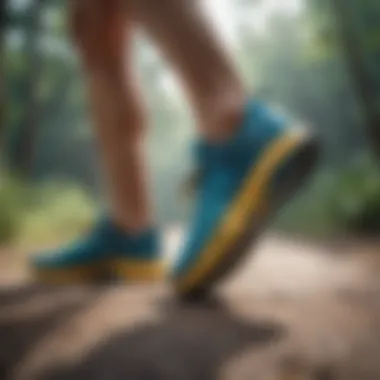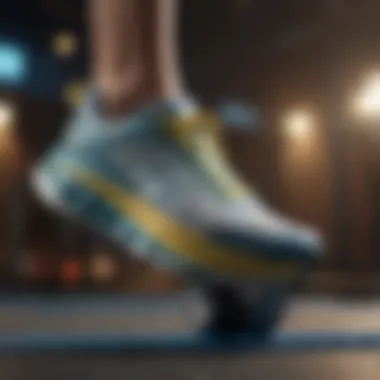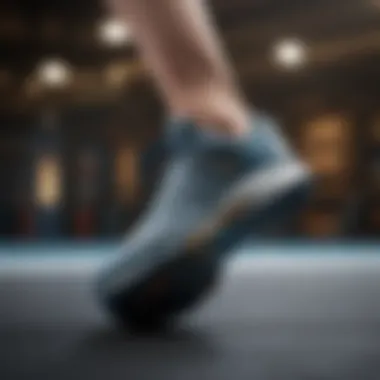Hoka One Footwear for Flat Feet: A Comprehensive Review


Intro
Flat feet, or pes planus, is a common condition where the arches of the feet are lowered or nonexistent. This can lead to discomfort during physical activities and can affect overall foot health. For individuals with flat feet, choosing the right footwear is crucial for maintaining stability, comfort, and performance. Hoka One, known for its innovative designs and cushioning technology, has garnered attention from the flat-footed demographic. This article delves into how Hoka shoes may offer relief and support for those with flat arches.
Key Takeaways
Hoka One footwear is specially designed to provide comfort and support, particularly for individuals with flat feet. Here are the main points to consider:
- Cushioning Technology: Hoka's signature cushioning helps to absorb impact, which is important for flat-footed individuals who may experience more stress on their joints.
- Arch Support: Many models provide varying degrees of arch support, catering specifically to those with flat arches.
- Heel Stability: Hoka shoes typically offer enhanced heel stability, which can assist in maintaining balance and reducing the risk of injury during movement.
- Lightweight Design: Despite the cushioning, Hoka footwear is often lightweight, which can encourage longer wear without causing fatigue.
Actionable insights for readers include evaluating your own foot mechanics, considering trying different models of Hoka to find the right fit, and consulting with a health professional if you have persistent foot pain.
In-Depth Analysis
Hoka One has emerged as a prominent player in the running shoe market, with its initial focus on maximal cushioning. The brand's philosophy centers on providing optimal comfort, which aligns well with the requirements of flat-footed individuals. Research suggests that inadequate support can lead to various musculoskeletal problems. A study published in the Journal of Foot and Ankle Research found that appropriate footwear can significantly alleviate discomfort for individuals with low arches.
Key Features of Hoka Footwear for Flat Feet
- Meta-Rocker Technology: This design encourages a natural gait cycle, allowing those with flat feet to move more fluidly.
- Wide Toe Box: Many Hoka models come with a wider toe box, which accommodates foot swelling and allows for natural toe splay.
- Dynamic Fit System: Some models provide a fit that adapts to the foot’s shape while in motion, ensuring comfort during activities.
"Proper shoe selection is critical in managing flat feet effectively and can lead to improved quality of life."
Finale
In summary, Hoka One offers various shoes that may serve the needs of individuals with flat feet effectively. With a focus on cushioning and support, these shoes may enhance both comfort and performance. It is essential to understand your own foot structure and to try different models to find the perfect fit. Whether for running, walking, or everyday wear, Hoka One’s innovative designs warrant consideration for anyone dealing with the challenges posed by flat feet.
Understanding Flat Feet
Understanding flat feet is essential for comprehending how specific footwear, like Hoka One, can support individuals with this condition. Flat feet, or pes planus, can significantly affect a person's daily activities and athletic performance. As we explore Hoka One's offerings, insights into flat feet will provide a contextual backdrop for the design elements that promote comfort and ease of movement.
Defining Flat Feet
Flat feet characterize a condition where the arch of the foot collapses or does not develop as it should. This results in the entire sole of the foot making contact with the ground. Flat feet can be present from birth or develop over time due to various factors, including age, injury, or obesity. Understanding the specific nature of flat feet is crucial for tailoring appropriate footwear solutions, which can prevent related discomfort and enhance overall foot health.
Impact of Flat Feet on Physical Activity
The consequences of flat feet extend into several facets of physical activity. The unique shape and biomechanics of flat feet can affect how individuals perform during activities like walking, running, and sports.
Pain and Discomfort
Pain and discomfort are common experiences for flat-footed individuals. The absence of adequate arch support leads to conditions such as muscle fatigue and pain in the foot's ligaments and tendons. This specific aspect of flat feet highlights the necessity for proper footwear to mitigate discomfort.
- Key characteristic: The lack of arch support.
- Advantage: Wearing supportive shoes can alleviate pain and improve the overall experience during physical activities.
Altered Gait Mechanics
Altered gait mechanics stem from flat feet, affecting how individuals walk or run. The flat nature of the foot can lead to compensatory movements in other joints, such as the knees and hips. Proper footwear addresses this aspect by enhancing stability and alignment.
- Key characteristic: Compensatory movements due to flat arches.
- Advantage: Utilizing suitable shoes can help restore normal gait patterns and reduce strain on the body.
Risk of Injuries


Flat feet present a higher risk for injuries, such as ankle sprains or knee pain, during physical activities. The foot's inability to absorb shock properly can lead to misalignment in joints, causing stress and potential injuries over time.
- Key characteristic: Increased likelihood of joint and ligament injuries.
- Advantage: Proper footwear can significantly mitigate these risks by offering the necessary support and stability.
Common Conditions Associated with Flat Feet
Flat feet can lead to various related conditions, each presenting unique challenges for individuals.
Plantar Fasciitis
Plantar fasciitis is a common condition that can develop in individuals with flat feet. The condition arises from inflammation of the plantar fascia, a thick band of tissue connecting the heel bone to the toes.
- Key characteristic: Pain in the heel and arch of the foot.
- Advantage: Recognizing the link with flat feet underscores the importance of supportive footwear, which can minimize strain on the fascia.
Achilles Tendinopathy
Achilles tendinopathy often occurs in flat-footed individuals, characterized by pain and stiffness in the Achilles tendon. The condition is often exacerbated by improper footwear.
- Key characteristic: Discomfort in the heel and lower calf.
- Advantage: Supportive shoes can help alleviate stress on the tendon and promote proper healing.
Knee Pain
Knee pain is another common issue associated with flat feet. The misalignment caused by flat arches can lead to increased pressure on the knee joints.
- Key characteristic: Pain during movement, especially after physical exertion.
- Advantage: Wearing shoes designed for flat feet can help align the body and reduce knee pain during activities.
Hoka One: Brand Overview
In the realm of athletic footwear, Hoka One holds a significant place, especially for individuals with flat feet. Understanding the brand's foundation and core beliefs enhances the reader's comprehension of how its products can cater to specific needs. Hoka One is not merely a shoe brand; it represents a philosophy built around performance, comfort, and innovative design. Each aspect of Hoka's offerings ties back to the importance of arch support and stability, which are crucial for flat-footed individuals seeking to improve their physical activity without discomfort.
History of Hoka One
Hoka One was established in 2009 by two French trail runners. The brand was born out of a desire to create a shoe that combined maximal cushioning with lightweight design. This unique approach aimed to enhance running efficiency while minimizing the risk of injury. Initially, Hoka footwear gained popularity among ultramarathon runners but soon expanded to a broader audience looking for reliable comfort and support. The growth of Hoka reflects its commitment to innovation, driving it to become a recognized leader in the athletic footwear industry.
Core Philosophy of Hoka One
Hoka’s core philosophy centers on three main pillars: maximalist cushioning, lightweight design, and performance focus. Understanding these principles is essential when evaluating how Hoka footwear can benefit flat-footed individuals.
Maximalist Cushioning
Maximalist cushioning refers to the emphasis on ample padding in the sole of the shoe. This characteristic significantly contributes to shock absorption, which is crucial for flat-footed individuals. The unique feature of this cushioning is that it helps in distributing impact evenly, reducing stress on flat arches. Many users find this beneficial, as it provides extra comfort during extended use. However, some argue that maximalist designs may compromise responsiveness in certain situations.
Lightweight Design
Lightweight design is another hallmark of Hoka shoes. The core idea behind this is to offer footwear that does not weigh down the wearer. For individuals with flat feet, this means that they can engage in prolonged physical activities without feeling fatigued. The shoe's construction often incorporates breathable materials that add to comfort while maintaining support. However, some users may perceive this as less durable than heavier models.
Performance Focus
Performance focus showcases Hoka's dedication to enhancing athletic capability. This aspect promotes a natural foot strike and encourages proper biomechanics. The brand pays meticulous attention to ensuring that its shoes support the foot's natural movement. For flat-footed individuals, this means reduced risk of injury while engaging in various sports and activities. However, finding the perfect balance between cushioning and performance may vary for each user, necessitating careful consideration when selecting a model.
"Hoka One's commitment to comfort and performance offers a viable solution for flat-footed athletes."


Hoka One Features for Flat Feet
Hoka One footwear offers various features that specifically address the needs of individuals with flat feet. Understanding these features helps users make informed choices about footwear. The design elements included in Hoka shoes aim to enhance comfort, stability, and performance. Key attributes such as arch support, cushioning technology, and upper fit contribute significantly to their effectiveness for flat-footed individuals. This part of the article will delve into these features, explaining how they can provide support and improve overall foot health.
Arch Support Mechanisms
Dynamic Stability
Dynamic stability is a critical aspect of Hoka footwear, ensuring that those with flat feet have the necessary support throughout their stride. This feature is designed to adapt to various surfaces while promoting a natural gait. One distinctive characteristic of dynamic stability is its ability to offer support without being overly rigid. This helps reduce the stress on muscles and joints, providing a smoother running experience. Many find this aspect beneficial as it efficiently manages foot motion, counteracting imbalances caused by flat arches. However, the need for a personal fit remains important, as some may require additional support.
Progressive Diagonal Roll
Progressive diagonal roll is another innovative mechanism found in Hoka shoes. It allows for a gradual transition during the gait cycle, which is useful for individuals with flat feet. This feature encourages proper foot alignment and helps to distribute impact more evenly. The defining characteristic of progressive diagonal roll is its unique design that promotes a natural rolling motion. This helps prevent excessive pronation, a common issue for flat-footed individuals. Although many users appreciate this design, some may find it takes time to adjust to this rolling effect.
Cushioning Technology
Compression-Molded EVA
Compression-molded EVA plays an essential role in Hoka's cushioning approach. It provides a lightweight yet effective layer of support, significantly absorbing impact. The primary characteristic of this material is its ability to return to its original shape after each step, ensuring long-lasting comfort. This feature makes compression-molded EVA a popular choice among runners and walkers alike. Its main advantage lies in its responsiveness, which can enhance the overall experience for those with flat feet. Nevertheless, some may find it less supportive than firmer materials in specific situations.
Meta-Rocker Technology
Meta-rocker technology enhances the running experience by facilitating a smooth transition from heel strike to toe-off. This design feature helps to create a more fluid motion when walking or running. The key characteristic of meta-rocker technology is its unique sole profile, which encourages efficient movement. This aspect makes it a valuable choice for flat-footed individuals, as it compensates for traditional gait limitations. However, while many users find this beneficial, a few may experience discomfort due to its distinctive shape during the initial use.
Upper Design and Fit
Breathability
Breathability plays a crucial role in maintaining foot comfort, especially for flat-footed individuals. Hoka shoes often incorporate breathable materials to promote airflow, preventing overheating during physical activity. A primary feature of breathability is its ability to wick away moisture, which can be essential for overall foot hygiene. Many users appreciate the comfort provided by breathable uppers, as this can lead to a more enjoyable experience while walking or running. However, in some cases, the trade-off may be reduced durability over time.
Adaptive Fit
The adaptive fit of Hoka shoes allows for a more personalized experience. This feature accommodates the various shapes of feet, ensuring a snug but not overly tight fit. Key characteristics of adaptive fit include flexible materials and designs that hug the foot without restricting movement. Such an approach is beneficial for flat-footed individuals, as it helps support the arch while allowing for natural foot motion. However, some users may find that the adaptive fit may not provide enough structure for their specific needs.
Selecting the Right Hoka Model for Flat Feet
Choosing the right model of Hoka footwear is crucial for individuals with flat feet. This area focuses on aligning the specific needs of flat-footed individuals with the various Hoka models available. The correct selection can significantly enhance comfort during physical activity and prevent potential injuries often associated with flat feet.
Evaluating Foot Type
Identifying Foot Shape
Identifying your foot shape is fundamental when selecting the right Hoka shoes. The right foot shape can affect how a shoe fits and performs. Those with flat feet typically have a wider forefoot and a lower arch. This characteristic influences how pressure is distributed across the foot during movement. Understanding your foot shape allows you to choose a model that provides better stability and comfort.
The unique feature of understanding foot shape is that it aids in selecting shoes that accommodate natural foot movement. This results in optimized support. Models designed for wider feet usually offer more room in the toe box, helping to reduce discomfort during extended wear.
Assessing Arch Height
Assessing arch height is another critical aspect of selecting Hoka shoes for flat feet. Low arches can lead to overpronation, which affects gait mechanics. Knowing your arch height gives insight into necessary support levels. For flat-footed individuals, a shoe offering additional cushioning and stability is advisable.
The importance of arch height assessment lies in its direct correlation with comfort and performance. The unique feature of this assessment is that it allows consumers to analyze their specific needs. Consequently, selecting shoes with appropriate arch support can help mitigate pain and improve overall foot function during physical activities.


Key Models to Consider
Bondi Series
The Bondi Series is notable for its maximalist cushioning, designed to provide ultimate comfort for flat feet. This model is a favorite among those seeking a smooth ride, especially over long distances. The cushioning absorbs impact effectively, reducing stress on the feet and joints.
A distinctive feature of the Bondi Series is its wider base, which enhances stability. The combination of this stability and cushioning makes it a strong choice for flat-footed individuals engaging in various activities.
Clifton Series
The Clifton Series is an excellent alternative for those looking for a balance between lightweight feel and cushioning. It is designed to be versatile, suitable for daily running and casual wear. One key characteristic of this model is its responsive cushioning, which adapts to the foot's movement.
This series stands out because it provides adequate arch support without compromising on comfort. However, it may not offer as much stability as the Bondi Series. Thus, it is essential to weigh personal needs when considering this model.
Arahi Series
The Arahi Series presents a unique approach with its focus on stability. This model is engineered for individuals needing additional control during their movements, crucial for flat-footed runners. Its distinctive feature is the J-Frame design, which provides support while maintaining flexibility.
This series is beneficial for runners prone to overpronation, offering a secure fit and adequate cushioning. Nevertheless, it may feel different compared to other Hoka models, especially for those not used to structured support.
"Selecting the appropriate Hoka model can have a significant impact on comfort and performance. It is not just a matter of choice but a step towards healthier foot mechanics."
User Experience and Reviews
Understanding the user experience for Hoka One footwear, especially among individuals with flat feet, provides valuable insights into the effectiveness and overall value of these shoes. Reviews from actual users deepen the analysis of Hoka's designs and contradict common misconceptions. Feedback can highlight specific features that provide comfort, support, and performance enhancements, relevant for flat-footed individuals.
Evaluating user experiences also draws attention to individual variations in foot structure and comfort preferences. It showcases how one model’s design suits some better than others, fostering informed decisions among potential buyers.
General Feedback from Flat-Footed Users
Flat-footed users often share their experiences with Hoka models that provide adequate support for their specific foot type. Common feedback indicates that many individuals appreciate the exceptional cushioning, which alleviates discomfort during prolonged use. The Bondi and Clifton series, for instance, are frequently mentioned for their plush padding, helping to absorb impact when walking or running.
Users often report a noticeable reduction in pain associated with conditions like plantar fasciitis, particularly after switching to Hoka shoes. The arch support functionality aligns with their unique needs, resulting in a more engaging physical activity experience.
However, it’s essential to consider mixed reviews as well. Some users express concerns about the shoe's heavy feel, preferring lighter alternatives for specific activities. Nonetheless, the overwhelming majority highlight a significant improvement in gait mechanics and overall comfort. In summary, feedback among flat-footed users reveals effective cushioning and support are key benefits of Hoka footwear, yet individual preferences can diverge based on activity level and foot sensitivity.
Expert Opinions on Hoka for Flat Feet
Expert insights further enhance the understanding of Hoka shoes within the context of flat feet. Many podiatrists and physical therapists recognize the brand’s attention to detail in addressing common issues associated with flat arches. The cushioning technologies used in Hoka shoes are often commended for promoting proper foot alignment, reducing excessive pronation, and preventing injuries.
"Hoka appears to strike an effective balance between comfort and support, making them suitable for those with flat feet. However, individualized assessments remain paramount." - Dr. Mike Sullivan, Podiatrist
Experts also underline the significance of fit and stability. They advise users to consider their foot shape and specific running or walking needs effectively, as these can determine the degree of support required. The Arahi series, for instance, is frequently highlighted for its stability features, making it a worthwhile option for those managing foot-related concerns. Additionally, professionals warn against relying solely on brand loyalty, stressing the importance of testing various models to find the most suitable fit.
End
The analysis of Hoka One footwear for individuals with flat feet provides valuable insights that can enhance comfort and performance. Flat feet often come with challenges that can diminish the quality of physical activity. Thus, it is vital to acknowledge the specific needs of flat-footed individuals when selecting appropriate footwear. Choosing the right shoe can prevent pain and discomfort, while enabling better engagement in physical activities.
Summary of Benefits for Flat Feet
When examining the benefits of Hoka One shoes for those with flat feet, several key elements stand out. Firstly, the arch support mechanisms employed in Hoka footwear, such as Dynamic Stability, work to provide necessary support that can improve gait and stability. This helps in reducing fatigue during prolonged wear.
Secondly, the cushioning technology, exemplified by the Compression-Molded EVA and Meta-Rocker technology, absorbs shock effectively. This feature is particularly important for flat feet, which can experience greater impact when walking or running. Adequate cushioning mitigates discomfort and enhances overall physical performance.
Additionally, Hoka One shoes are designed with a focus on breathability and adaptive fit within their upper design. This ensures that the shoes not only accommodate flat feet but also maintain comfort over time. The overall weight of the shoes is another benefit, as a lightweight design reduces the burden on flat-footed individuals, fostering better movement and agility.
Final Thoughts on Hoka One Footwear
Reading experiences from flat-footed individuals reveals that many have found pronounced improvements in comfort and performance after transitioning to Hoka footwear. Such testimonials underscore the brand’s commitment to supporting people with unique foot structures. Ultimately, when considering footwear for flat feet, Hoka One deserves attention for its innovative approach and dedication to comfort.





